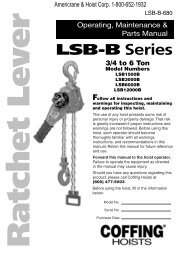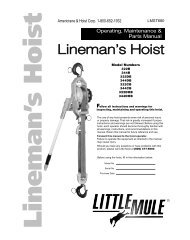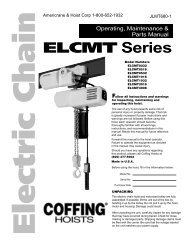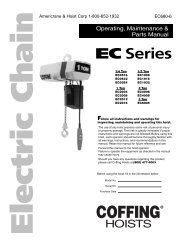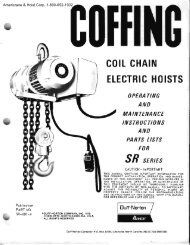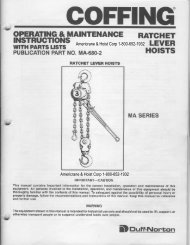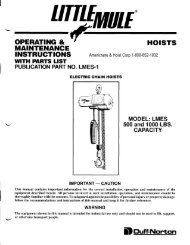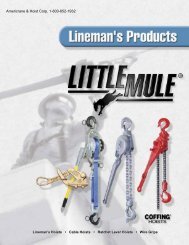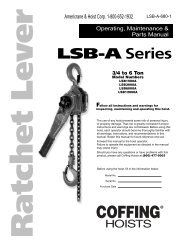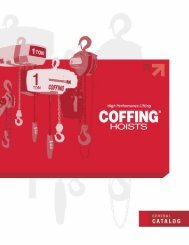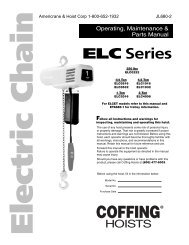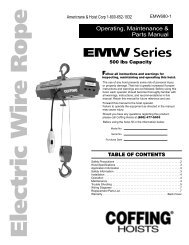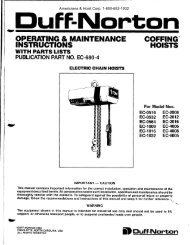JLC Series, JLC680 - Coffing Hoists, Coffing Hoist Parts
JLC Series, JLC680 - Coffing Hoists, Coffing Hoist Parts
JLC Series, JLC680 - Coffing Hoists, Coffing Hoist Parts
You also want an ePaper? Increase the reach of your titles
YUMPU automatically turns print PDFs into web optimized ePapers that Google loves.
Country Club Road<br />
P.O. Box 779<br />
Wadesboro, NC 28170 USA<br />
TEL: (800) 477-5003<br />
FAX: (800) 374-6853<br />
INSPECTION AND MAINTENANCE CHECK LIST<br />
ELECTRIC POWERED OVERHEAD CHAIN HOIST<br />
Type of <strong>Hoist</strong> ___________________________________________________________<br />
Location _______________________________________________________________<br />
Manufacturer___________________________________________________________<br />
Capacity (Tons) _________________________________________________<br />
Original Installation Date _______________________________________<br />
Manufacturer’s Serial No. _______________________________________<br />
Item Frequency of Inspection Possible Deficiencies OK Action<br />
Required<br />
Frequent Periodic<br />
Daily Monthly 1-12 Mo.<br />
Operating Controls * * * Any deficiency causing improper operation<br />
Limit Switches * * * 1. Any deficiency causing improper operation<br />
2. Pitting or deterioration<br />
Brake Mechanism * * * 1. Slippage or excessive drift<br />
2. Glazing, contamination or excessive wear<br />
Hooks<br />
* * * Excessive throat opening 15% bent or twisted more than 10<br />
degrees, damaged hook latch, wear, chemical damage,<br />
worn hook bearing. Cracks (use dye penetrant, magnetic or<br />
other suitable detection method)<br />
* * * Cracks, excessive wear or other damage which may impair<br />
Suspension Lug (if used)<br />
the strength of the lug. Cracks (use dye penetrant,<br />
magnetic particle or other suitable detection method)<br />
Chain * * * Inadequate lubrication, excessive wear or stretch, cracked,<br />
damaged or twisted links, corrosion or foreign substance<br />
Hook and Suspension<br />
Lug Connections<br />
* Cracks, bending, stripped threads<br />
Pins, Bearings, Bushings<br />
Shafts, Couplings<br />
* Excessive wear, corrosion, cracks, distortion<br />
Nuts, Bolts, Rivets * Looseness, stripped and damaged threads, corrosion<br />
Sheaves<br />
Housings, Load Block<br />
* Distortion, cracks, and excessive wear.<br />
Build-up of foreign substances<br />
* Cracks, distortion. Excessive wear, internal build-up of<br />
foreign substances<br />
Wiring and Terminals * Fraying, defective insulation<br />
<strong>Hoist</strong> Reversing<br />
Contactor, other Electrical * Loose connections, burned or pitted contacts<br />
Apparatus<br />
Supporting Structure and Trolley * Damage or wear which restricts ability to support<br />
(if used)<br />
imposed loads<br />
Nameplates, Decals,<br />
Warning Labels<br />
* Missing, damaged or illegible<br />
Transmission Lubricant * Low level requires changing<br />
NOTE: Refer to Maintenance and Inspection Sections of the <strong>Hoist</strong>-Maintenance Manual for further details.<br />
FREQUENCY OF INSPECTION<br />
Frequent — Indicates items requiring inspection daily to monthly. Daily inspections may be performed by the operator if properly designated.<br />
Periodic — Indicates items requiring inspection monthly to yearly. Inspections to be performed by or under the direction of a properly designated period. The exact<br />
period of inspection will depend on frequency and type of usage. Determination of this period will be based on the user’s experience. It is recommended<br />
that the user begin with a monthly inspection and extend the periods to quarterly, semi-annually or annually based on user’s monthly experience.<br />
Figure 10A — Recommended Inspection and Maintenance Check List<br />
NOTE: This inspection and maintenance check list is in accordance with our interpretation of the requirements of the Safety<br />
Standard for Overhead <strong><strong>Hoist</strong>s</strong> ASME B30.16. It is, however, the ultimate responsibility of the employer/user to interpret and<br />
adhere to the applicable requirements of this safety standard.<br />
16



